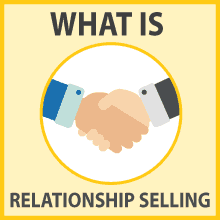
A lot of sales teams struggle with a lack of loyal customers and the constant hassle of searching for new prospects. But what if I told you that there is a way to nurture сustomers who only want to do business with you? Relationship selling is a strategy designed to convert prospects for the long-term — for years! — instead of the one-time sale that most sales reps pursue.
And the best part?
It doesn’t require your sales team to invest in extra solutions or platforms. Relationship selling is more of a mindset change than a toolset change.
If you’re a regular reader of the LeadGibbon blog, you probably noticed that I’m a big fan of relationship selling (our guide to sales prospecting or a perfect sales strategy checklist both mention a lot of relationship selling techniques).
I think today is the right time to explain what exactly relationship selling is and how you can use it to achieve more sales, drive engagement and build a future-proof sales funnel.
Ready to learn why thinking long-term is the way to go? Then read on!
Let’s start with the relationship selling definition
There are a lot of fashionable barbershops in my town. But when the time for a haircut comes, I always find myself scheduling a session at the same hairdressing salon I’ve been visiting since…
Well, since I was a child. And I always wondered why.
Am I scared to try something new? Or do I believe that my usual haircut makes me the most handsome guy on the block? (It obviously does, but that’s not relevant.)
And then it hit me: I know my hairdresser.
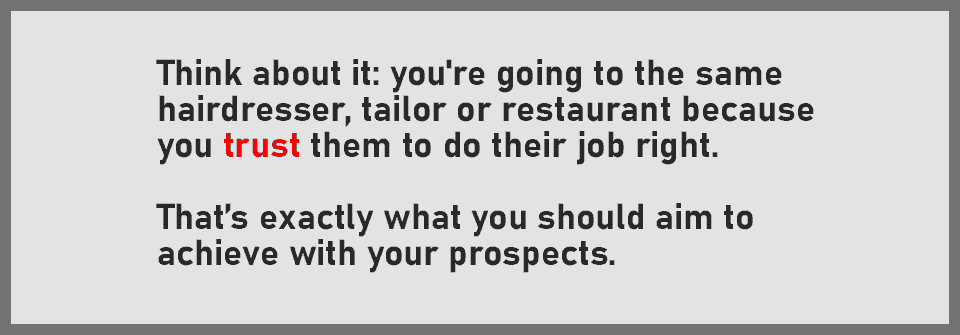
Whenever I come in to have a haircut we start chatting. She asks me how I’ve been and shares some news about her own life.
I trust my hairdresser to cut my hair the way I want. She trusts me to be on time and have the money to pay for her service. We have a relationship built on trust — and each month, that relationship translates to revenue for that particular salon.
Boom! That’s relationship selling in a nutshell.
It doesn’t matter whether you’re a hairdresser at a local barbershop or a sales rep at an international cyber security company. Customers want to do business (any kind of business) with people they trust and like.
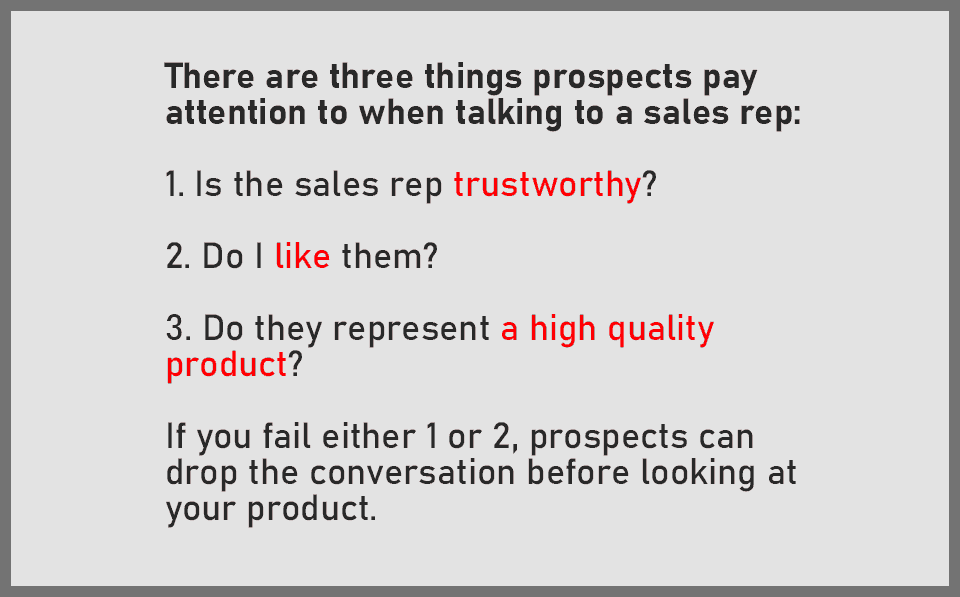
By the way, here’s some crazy truth for you: prospects want to like you.
Yeah, their first instinct (as we said in our post on sales rebuttals) might be to reject you, but that’s only because they are so accustomed to low-quality sales pitches.
But to receive a great pitch from somebody you like? Who seems genuinely interested in helping you achieve your goals?
For a prospect, that’s a dream.
If you start routinely pursuing prospects with the goal of building trust with them (as opposed to immediately pitching your product), soon you’ll leave your competition far, far behind. Remember the Liking principle of persuasion?
I believe that relationship selling leads to better results both for the customer and the sales rep. So here’s a definition that reflects this:
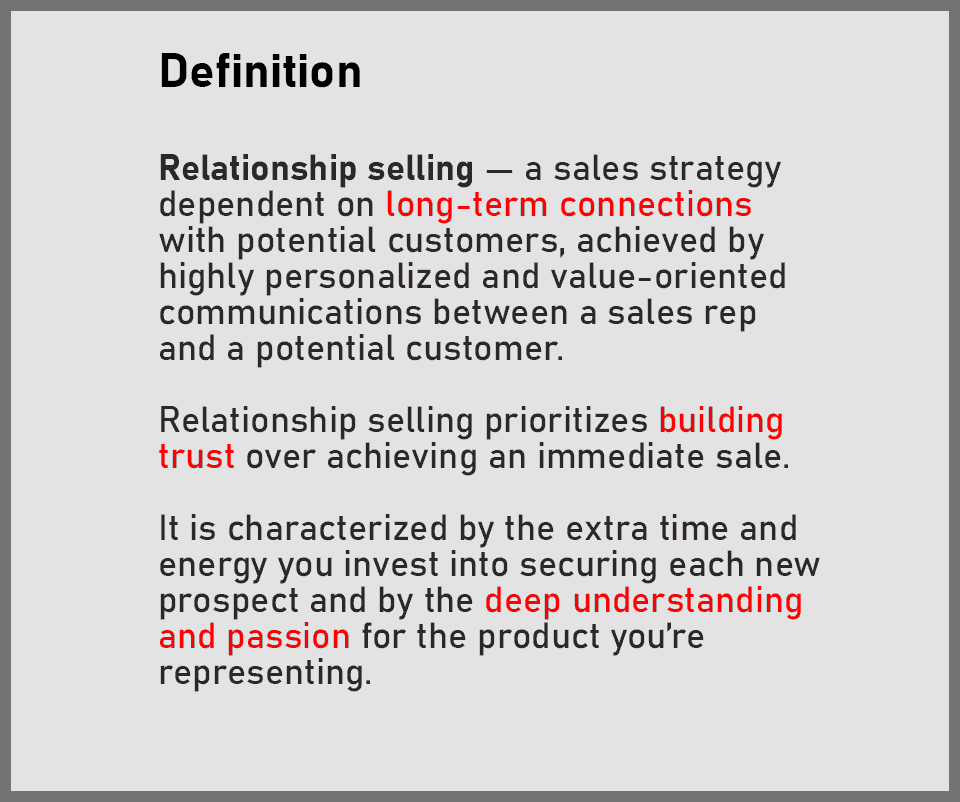
When done right, relationship selling is a strategy that will make your business future-proof.
Everybody else is playing the quantity game. A lot of effort for low-quality results, and exactly zero motivation for a sales team. Think about sales reps who make hundreds of cold calls per day, only to achieve a 2.5% success rate.
On the other hand, relationship selling is the quality game. You aim to convert leads for the long term.
So when your competition struggles to find new prospects to make up for the customers they lost – you’ll be growing your business because all of your previously converted prospects will stay on board.
If they trust you and like you, what’s the reason for them to look for alternatives?
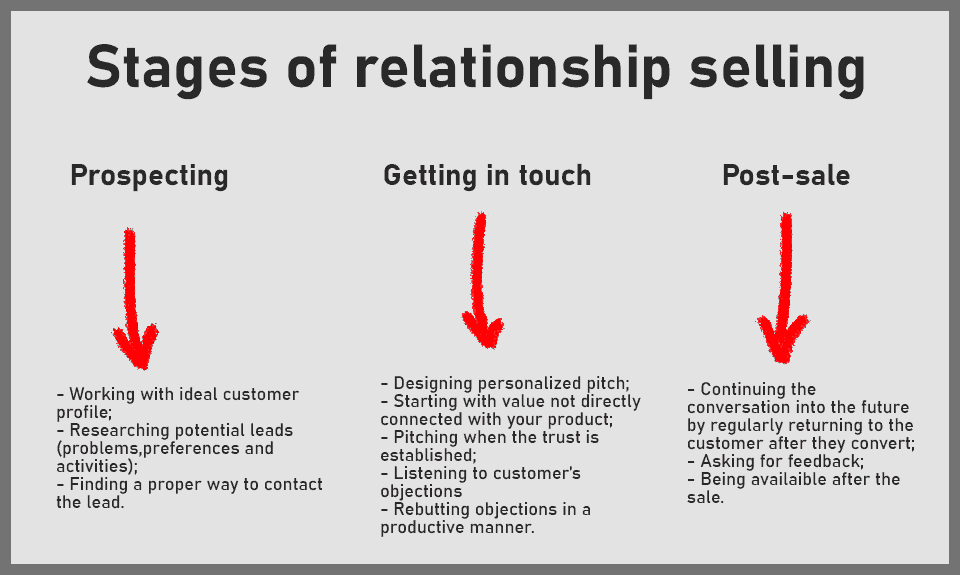
Relationship selling vs transactional selling: the difference in mindsets
The opposite of relationship selling is called transactional selling.
There’s nothing inherently wrong with transactional selling. By definition, it’s simply swapping money for goods. If you need to buy a new phone, you don’t wait for a sales rep from Best Buy to send you a heavily personalized message.
Instead, you just go to Best Buy and buy a new phone.

But most businesses are not Best Buy and they are not selling phones. So isn’t it more logical to invest time and effort into finding the right prospects (based on your ideal buyer profile) and building a long-term relationship with them?
I think you’ll agree that it’s easier to keep an existing customer than to find a new one (it’s actually 6 to 7 times less expensive according to Brevet).
Here are some examples of businesses that can win by implementing relationship selling techniques:
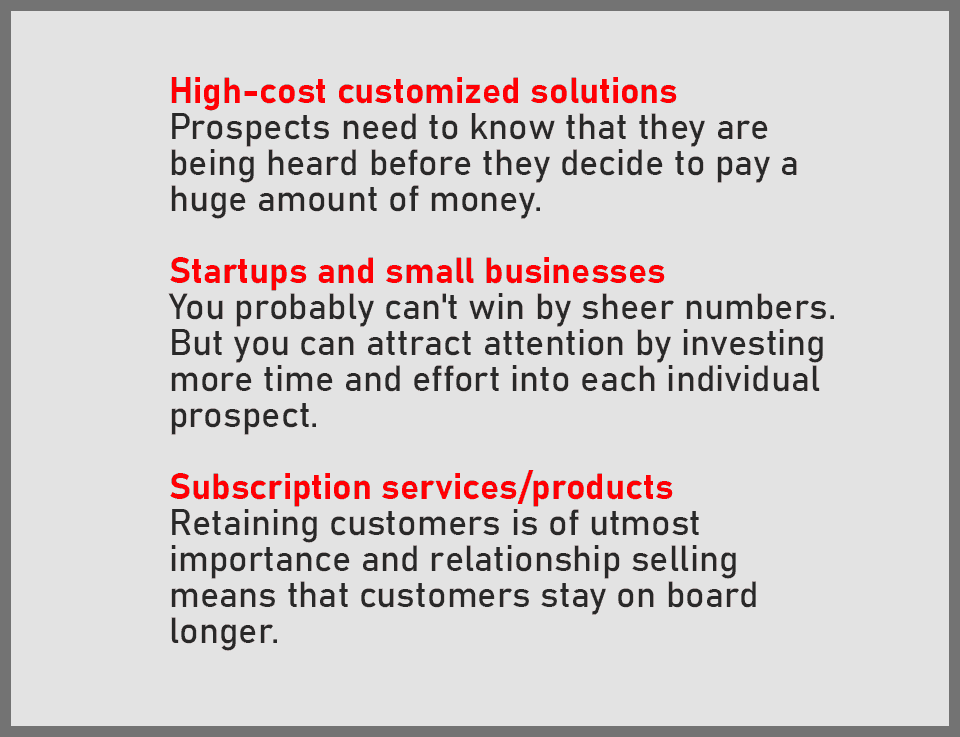
However, a staggering amount of sales reps either forget about a customer once they convert them or don’t invest enough effort into converting them in the first place. Considering this, is it surprising that nurtured customers make purchases that are 47% larger than purchases of non-nurtured leads?
(Maybe that’s because sales reps are generally overstressed and underprepared. That’s what 82% of decision-makers in the B2B industry think, anyway.)
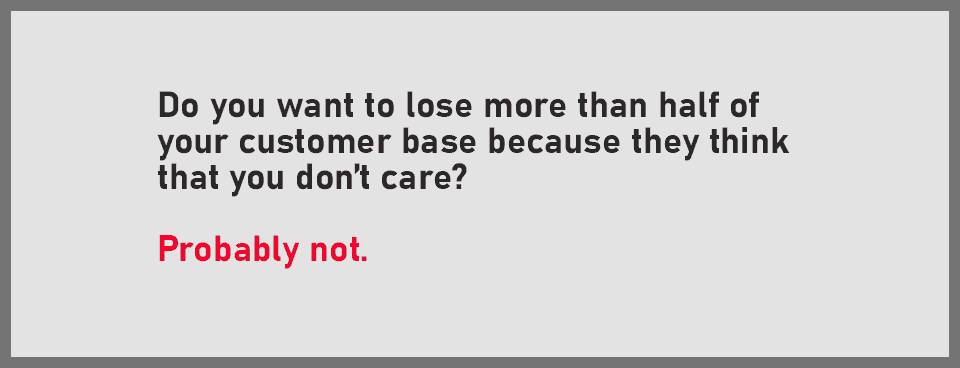
Relationship selling tips and examples
Tip #1: Relationship selling starts with prospecting
It’s not that hard to buy a list of everyone even remotely connected to your industry (and their grandma).
But it doesn’t make much sense — most people you message will ignore you, and the people who do sign up will probably lose interest quickly and drop out, because it wasn’t a good fit.
It’s a completely different story if you approach prospects with the goal of setting up a continuous relationship. It means that the prospects you find are better suited for your pitch, they will reply more eagerly, and you’ll have more time to prepare and personalize your message.
One of the best ways to reframe your sales prospecting around relationships is using LinkedIn Sales Navigator. Its advanced search features help you find prospects who perfectly suit your ideal customer profile.

Read this post to learn more Sales Navigator tips
If the prospect is active on LinkedIn, chances are that they are posting relevant material and articles on their profile pages. These can be used either as your ‘way in’ to contact that prospect (by commenting on their articles) or as your research material for later (to find topics to mention in your cold email, for example).
Tip #2: Don’t stop the research
This is the step that all sales reps believe is important… but most don’t take very seriously (again, playing the quantity game).
And honestly? I can understand them.
When there are so many potential customers to contact and so little time to do it, it’s easy to cut on the time that it takes to research each individual prospect. But if you don’t do it, don’t expect to reap the benefits of relationship selling.
Why? For a prospect, it’s obvious when the message they receive is an automated template or a generic call. This article by Ahrefs summarizes nicely why prospects won’t reply if you skip out on research (it’s about blogger outreach, but the same rules apply).
On the other hand, here are some examples of what you can find if you do research properly and how you can use it to build a relationship:
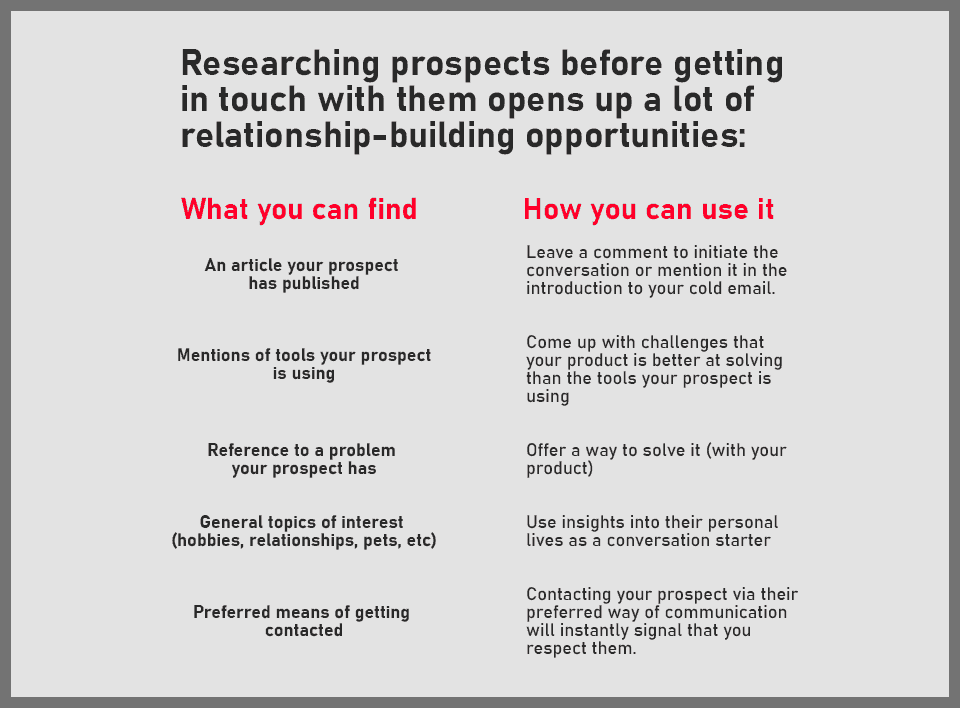
Researching the people you plan on getting in touch with is crucial to your success. Why? Because 87% of customers feel that sales reps can’t understand their needs (Brevet). Being in the other 13% is a great way to outsmart your competition.
Think about it this way. If you don’t do your research, the only thing you can offer your prospect is your product… but you won’t be able to explain why your product is a great fit for them.
Tip #3: Come up with a message that sounds personal
Instead of immediately talking about your sales pitch, prioritize building trust. The first thing to do here is learning how to sound human in your business communications.
Sales reps send so many messages each day, that they are easily susceptible to falling back onto sales clichés once they talk to a prospect. You probably received a message that began with ‘I’ve stumbled upon your blog’ more than once.

(Source: Gareth Wade, Chief Sales Officer at content26)
How do you make your language sound more natural? Consider implementing some of these tips in your sales routine:
- Write fun and personalized subject lines for your cold emails;
- Don’t shy away from jokes, personal stories or small talk;
- Simplify your email signature;
- Come up with a fun out-of-office message;
- Mention something you and your prospect have in common.
Do that for emails, calls and Skype conversations. In no time prospects will consider you as more of a friend than a robotic representative from some company they have never heard of.
Tip #4: Value first!
Here’s my favorite way to build trust. Offer something of value before pitching your own product.
Don’t believe me? Then listen to the expert, Robert Cialdini, who summarized this idea as the principle of reciprocity. Basically, people reward behavior that they find helpful and useful to them.
Send a blog post that you think your prospect will find interesting. Ask them for an opinion (everyone likes being called an expert). Share your thoughts about something they discussed on Twitter. Mention a deal on that thing they’ve been wanting to purchase.
It’s hard to overstate how important it is to start your conversation with a potential customer with something that is not your sales pitch. A sales pitch is easily ignored — your prospect is probably using something already.
But a helpful idea? A relevant tip? Positive feedback? Not so much.
Tip #5: Don’t stop the conversation
Here’s how most sales reps approach their conversations with prospects:
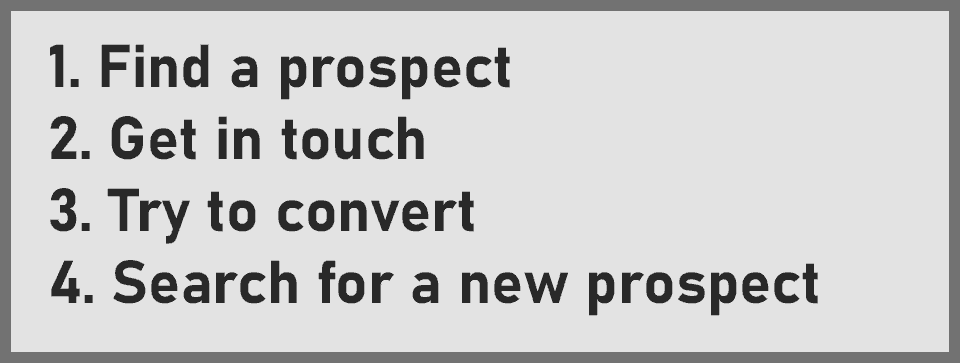
That’s the transactional selling mindset. It might win you a deal… but that prospect probably won’t stay for long.
Why? Because you’re not continuing the conversation after the deal went through.
On average, businesses are losing up to 30% of their customers each year (HubSpot). Yet 87% of sales reps say that their teams continue to miss important opportunities to reach out to prospects (SalesHacker).
Remember the rule of 78? Customers you bring on board at the beginning of a sales period, will make you the most money by the end of it — but only if you manage to keep them on board. Regularly checking in to see how your customers feel will make them more loyal, minimizing the risk of customers looking for alternatives.
Ask your customers for feedback, send them new information and talk to them to learn their opinion about your product. It’s especially important for subscription-based products, where businesses live and die by their churn rate.
Tip #6: Go an extra step
f your prospect sees that you’re doing them an extra favor, they will develop trust and loyalty for your product.
I really like this example by live chat platform HelpCrunch. The team developed an extra feature solely to meet the request of one of their customers:

(Source: HelpCrunch)
Intercom might be the big guys in the in-app messaging space right now. But I’m willing to bet that that particular customer is going to stay loyal to HelpCrunch for as long as they can because they’ve been heard.
Of course, not everyone can dedicate resources to building a whole new feature for a single customer. But every small step counts — including rescheduling meetings to accommodate your customer’s schedule and offering special discounts /promotions to reward loyalty.
Tip #7: Be honest, reliable and learn to listen
As relationship selling is something that’s designed for long-term benefits, it’s important to position yourself from the very beginning as an honest and reliable individual. If your prospect is asking something, reply as soon as possible with concrete things of value.
For example, a couple of years back I was working at another company and I was charged with explaining the services that the company offered to potential customers. After a month on board, I could answer most of their inquiries — but the API-related questions were still too complicated for me.
I could’ve just copied and pasted the URL to the API-related article from that company’s wiki… But I knew it wasn’t convenient for the customer to search through all that information to find what they were looking for. So instead I acknowledged that I didn’t possess the knowledge to answer their question and promptly got back to them with a concise response after speaking with our developers.
It worked like a charm.
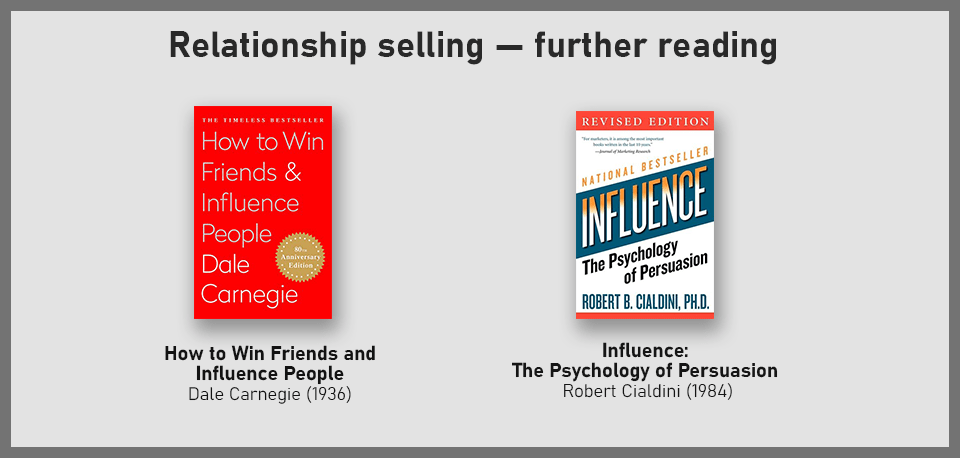
What’s even more important is learning how to listen.
According to HubSpot, 69% of customers are looking for sales reps who can listen to their needs. So don’t rush to giving them your pitch. Instead, try to learn what they are looking for, clarify anything that might be a misunderstanding and make notes to remember exactly what that customer said.
Tip #8: Don’t ignore a chance to meet
I have a feeling that most people who read this post are probably doing most of their sales communications via emails.
LeadGibbon is a tool for extracting email addresses after all… so that would make sense.
But I feel that it’s important to stress how crucial talking to a customer face to face can be. Why? Well, according to this study by Harvard Business Review, face-to-face requests can be 34 times more successful than emails.
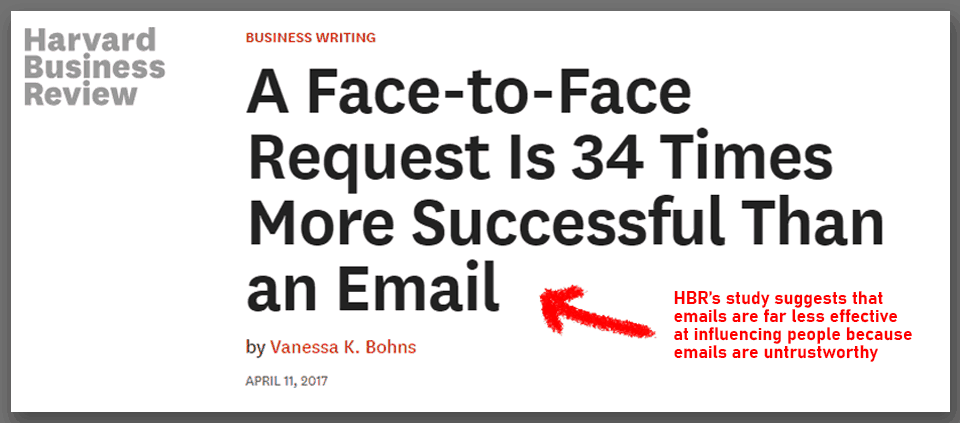
Try to make it a point to have video or Skype calls with your prospects. And for the most important deals, try to meet your prospects in person. This way you’ll achieve more trust and perhaps more opportunity to clearly explain your product or service.
Just be prepared to offer a careful rebuttal.
Conclusions
I hope that this article convinced you that relationship selling is essential for the long-term success of most businesses. But what do you think? Have you tried any of these techniques?
As always, we want to hear from you, so don’t hesitate to leave a comment in the section below!

Well you may persuade me but it might not be practical?
I read this artical and would like to use some of the content in a new book im publishing on pratical persuasion. Would you be so kind to allow me to use it in my book ?